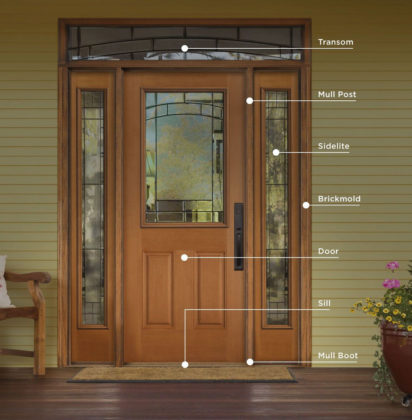Transom
A transom refers the window that sit above the door. They are typically a half circle, but can also be elliptical, rectangular, or come in a full circle.
Mull Post
This is the structural post between the sidelite (see next definition) and the door. Doors without sidelites do not have mull posts, they only have jambs. A mull post in essentially a “double-sided” jamb. This is used to help cover the seal between a door and the sidelites to give it a “cleaner” look and appearance.
Sidelite
A fixed narrow panel, installed next to a door panel, for decorative purposes. They almost always contain glass lights. Sidelights are normally designed to occupy a position adjacent to exterior doors, either in a common frame with the door or in a separate frame.
Brickmold
Brickmold is used as casing / border around exterior doors. It is most commonly used in pre-hung units and will often be called trim or casing. Brickmold can be made of different materials: fingerjoint pine, composite, vinyl or stain grain wood. The key differences between material are the cost and the durability (more durable = more expensive).
Door Slab
The door slab is the largest and most important component, and probably the most well-known. It, however, is not the only one that matters. The performance of a door us ultimately tied to the components that surround it. The best door slab in the world will not perform with losse hinges, rotten jambs or a leaky sill.
Sill
A horizontal beam below the door that supports the frame; a flat metal bar screwed to the floor that prevents the door from swinging through and helps keep the elements out. Sills are designed with a slope/ramp that goes from the inside of home sloping down to outside. It always sends water away from the home/building.
Mull Boot
A plastic component that covers the end of the mull post (where it meets the sill); mull boots protect the mull post from water damage that leads to rotting. Not a required part of the door frame, but a good investment for wet climates.

